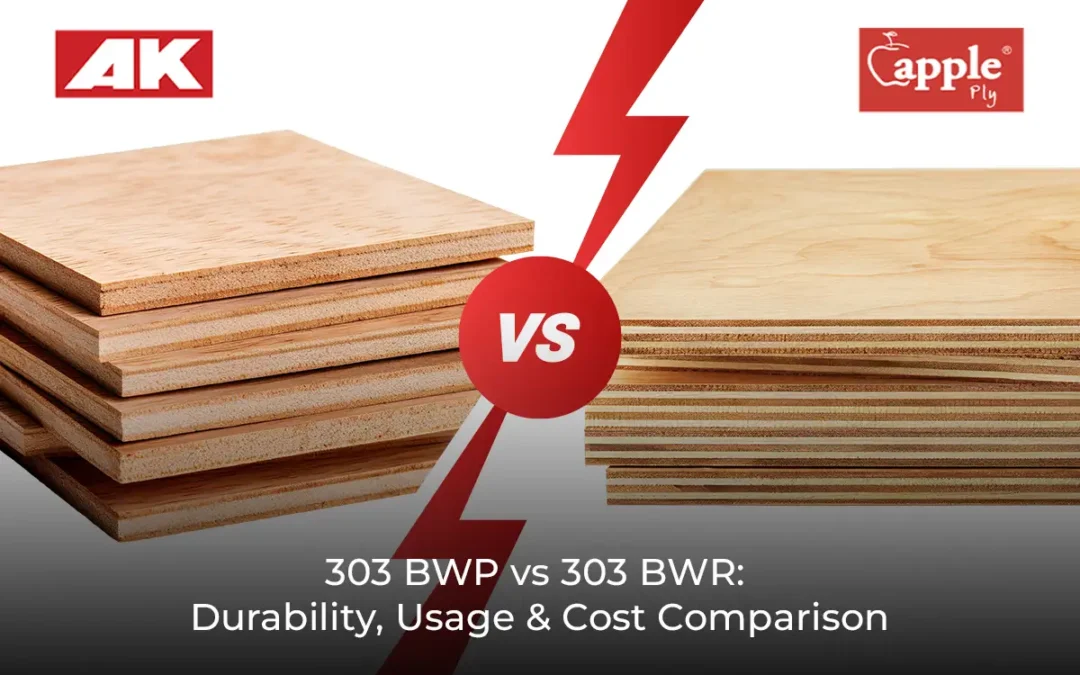What if choosing the right plywood could mean the difference between a structure that lasts for decades and one that weakens with time?
When it comes to durability, water resistance, and cost-efficiency, the debate around 303 BWP vs 303 BWR Plywood is more relevant than ever. Whether you’re building kitchen cabinets, bathroom vanities, or furniture for high-moisture areas, understanding the difference between these two types is crucial.
In this blog, we’ll break down the key differences in durability, usage, and cost between 303 BWP and 303 BWR Plywood so you can confidently select the best option for your project.
What do BWP and BWR Actually Mean?
Before diving into comparisons, let’s decode the acronyms:
- BWP (Boiling Water Proof) plywood is engineered to resist prolonged exposure to water and moisture. It’s the ideal choice for high-humidity or water-prone areas.
- BWR (Boiling Water Resistant) plywood, on the other hand, offers decent water resistance but isn’t designed for constant water exposure.
Plywood Durability Comparison: Who Wins the Strength Test?
When it comes to plywood durability comparison, BWP Plywood takes the lead. Thanks to its superior bonding using phenol formaldehyde resin, it can withstand boiling water for up to 72 hours. It’s highly durable, termite-resistant, and made for long-term use.
BWR plywood, though strong and suitable for interiors, is bonded with melamine-based adhesive and can only endure boiling water for about 8 hours. It’s good but not unbeatable.
Verdict:
BWP plywood is your go-to for bathrooms, kitchens, outdoor furniture, and other wet zones.
BWR plywood works well for bedroom furniture, partitions, and dry area cabinetry.
Usage Decoded: Where Should You Use Each Type?
Let’s break it down room by room:
| Area | Recommended Plywood |
| Kitchen Cabinets | 303 BWP |
| Bathroom Furniture | 303 BWP |
| Wardrobes | 303 BWR |
| Living Room Shelves | 303 BWR |
| Garden or Balcony Units | 303 BWP |
Understanding the difference between BWP and BWR plywood can prevent future swelling, warping, or damage due to water exposure.
Cost of 303 BWP vs 303 BWR Plywood: What’s the Price Difference?
Naturally, better performance comes at a slightly higher price. The cost of 303 BWP vs 303 BWR plywood varies depending on thickness and brand.
- 303 BWR Plywood: More budget-friendly, suitable for cost-conscious interiors.
- 303 BWP Plywood: Slightly more expensive but delivers long-lasting performance—well worth the investment in wet zones.
💡Pro Tip: Instead of cutting corners, consider where you truly need waterproofing to optimize your spend.
Comparison Table: 303 BWP vs 303 BWR Plywood
| Parameter | 303 BWP Plywood | 303 BWR Plywood |
| Full Form | Boiling Water Proof | Boiling Water Resistant |
| Durability | High – Can withstand boiling water for up to 72 hrs | Moderate – Resists boiling water for up to 8 hrs |
| Bonding Resin | Phenol Formaldehyde (PF) | Melamine-based adhesive |
| Water Resistance | Excellent – Ideal for wet zones | Moderate – Best for dry or semi-dry areas |
| Termite Resistance | No | No |
| Typical Usage Areas | Kitchens, Bathrooms, Balconies, Outdoor Furniture | Bedrooms, Living Rooms, Wardrobes, Dry Cabinets |
| Cost | Slightly Higher – Premium quality | More Budget-friendly |
| Lifespan | 15–25 years (with proper maintenance) | 8–15 years (in dry conditions) |
| Ideal Buyers | Looking for long-term, water-resistant furniture | Cost-conscious users focusing on dry-area interiors |
Final Verdict: Which Plywood Should You Choose?
If you’re looking for maximum durability and water resistance, 303 BWP plywood is the clear winner, especially for kitchens, bathrooms, and outdoor uses. For general interior furniture in dry spaces, 303 BWR plywood offers excellent value for money without compromising too much on strength.
Choose Quality. Choose Confidence. Choose AK Apple Plywood
Whether you pick BWR for budget-friendly interiors or BWP for water-resistant strength, AK Apple Plywood delivers IS:303-certified plywood you can trust. As the first brand to get the 303 BWP Plywood license in Kerala and Karnataka, we ensure every sheet meets the highest industry standards.
Ready to start your project with the best?
Visit AK Apple Plywood today or connect with our experts to get premium-quality plywood tailored to your needs.
Frequently Asked Questions (FAQs)
1: What’s the core difference between 303 BWP and 303 BWR plywood in terms of water resistance?
When comparing 303 BWP vs 303 BWR Plywood, the major difference lies in their water resistance. BWP (Boiling Water Proof) can withstand continuous exposure to water, making it ideal for kitchens, bathrooms, and exteriors. BWR (Boiling Water Resistant), while water-resistant, isn’t as durable under prolonged wet conditions—better suited for semi-wet areas like dining or living rooms.
2: Which one is better for kitchen cabinets—303 BWP or 303 BWR plywood?
In the debate of 303 BWP vs 303 BWR Plywood, 303 BWP clearly wins for kitchen cabinets. The constant moisture and steam in kitchen environments demand high durability, and BWP plywood’s superior waterproof glue and treatment ensure long-lasting performance compared to BWR.
3: Can I use 303 BWR plywood for exterior applications?
While 303 BWR offers moderate water resistance, it’s not ideal for full exterior use. If you’re considering 303 BWP vs 303 BWR Plywood for outdoor furniture or façade paneling, BWP is the better investment due to its enhanced weatherproofing and resistance to fungal and borer attacks.
4: How does the cost of 303 BWP compare to 303 BWR plywood, and is the price difference justified?
The cost of 303 BWP plywood is typically 15–25% higher than 303 BWR, depending on brand and quality. In a 303 BWP vs 303 BWR Plywood comparison, the price hike is justified if your application involves moisture or long-term durability.
5: What are the best use cases for 303 BWR plywood despite its lower durability?
Though BWR doesn’t match BWP in water resistance, it has its advantages. In the context of 303 BWP vs 303 BWR Plywood, BWR shines in dry zones—bookshelves, wardrobes, partitions, and wall panels. It’s more economical and perfectly suited for indoor, low-moisture environments.




